
Guitar Maintenance
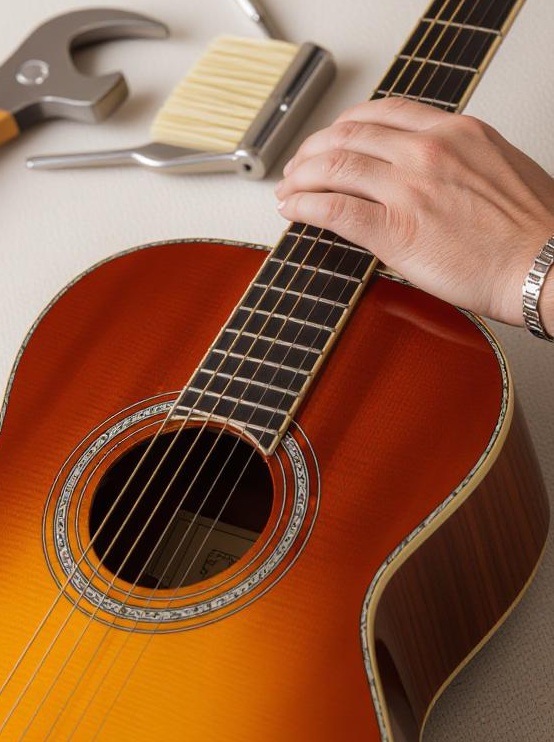
To keep your instrument sounding great and playing smoothly, regular maintenance is necessary. Proper care extends the life of the guitar, preserves its tone, and ensures it remains easy to play. There are some key practices for maintaining both acoustic and electric guitars, including cleaning, storage, string care, setup adjustments, and more. Here are some practical steps to keep your guitar in top condition.
1. Cleaning Your Guitar
Body and Finish
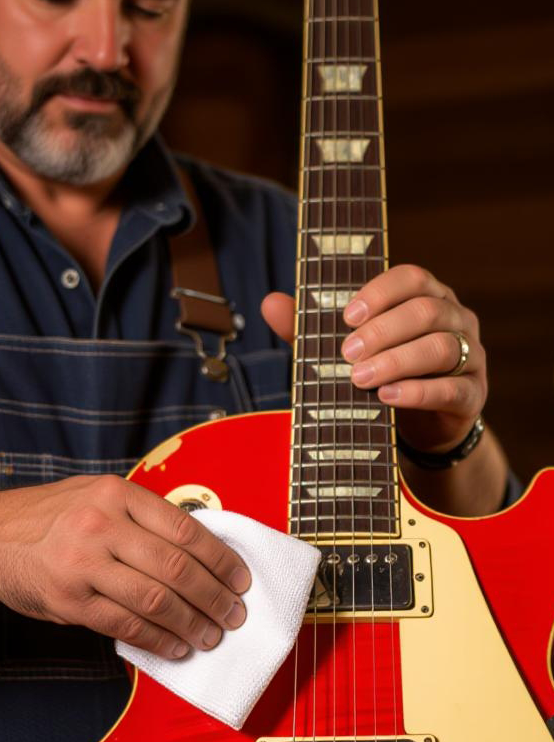
The guitar’s body collects dust, sweat, and oils from your hands, which can dull the finish and degrade the wood over time. Clean the body after every few playing sessions or at least once a month.
Materials Needed:
- Microfiber cloth
- Guitar polish (specifically formulated for guitars)
- Water (for light cleaning)
Steps:
- Wipe down the body with a dry microfiber cloth to remove dust and smudges.
- For stubborn grime, slightly dampen the cloth with water—never spray water directly on the guitar.
- Apply a small amount of guitar polish to the cloth (not the guitar) and gently rub in circular motions.
- Buff with a dry microfiber cloth for a streak-free shine.
Tips:
- Avoid household cleaners, as they can damage the finish.
- For nitrocellulose finishes (common on vintage guitars), use polish designed for delicate surfaces.
- Clean around hardware like tuning pegs and bridge to prevent corrosion.
Fretboard
The fretboard accumulates dirt, oil, and dead skin, which can affect playability and tone. Clean it every time you change strings.
Materials Needed:
- Lemon oil (for rosewood or ebony fretboards)
- Steel wool (0000 grade for unfinished fretboards)
- Microfiber cloth
Steps:
- Remove the strings (more on this later).
- Gently rub the fretboard with 0000 steel wool to remove grime, moving along the grain of the wood.
- Wipe away debris with a microfiber cloth.
- Apply a small amount of lemon oil to condition the wood, let it sit for a minute, then wipe off excess.
Tips:
- Maple fretboards (often sealed) require only a damp cloth, no oil.
- Over-oiling can soften the wood, so use lemon oil sparingly (once or twice a year).
Strings
Dirty strings sound dull and are harder to play. Clean them after every session to extend their life.
Steps:
- After playing, wipe strings with a clean, dry microfiber cloth to remove oils and sweat.
- For deeper cleaning, use a string cleaner or rubbing alcohol on a cloth, wiping each string individually.
Tips:
- Coated strings (like Elixir) last longer but still need cleaning.
- Replace strings when they feel rough or sound flat, typically every 1-3 months for regular players.
2. String Care and Replacement
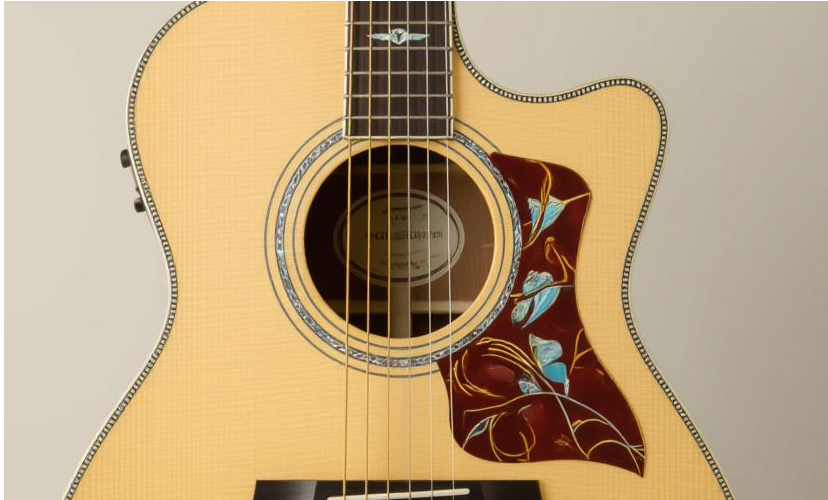
Strings are the heart of your guitar’s sound. Old or worn strings lose brightness and intonation, so regular replacement is key.
When to Change Strings:
- Acoustic guitars: Every 1-2 months for frequent players, or when tone dulls.
- Electric guitars: Every 2-3 months, depending on playing frequency and string type.
- Signs of wear: Rust, discoloration, or difficulty staying in tune.
To change strings, see our article on Guitar Restringing
3. Storage and Environmental Control
Guitars are sensitive to temperature, humidity, and physical damage. Improper storage can cause wood to crack, necks to warp, or glue joints to fail.
Ideal Conditions:
- Humidity: 45-55% relative humidity to prevent cracking (too dry) or swelling (too humid).
- Temperature: 65-75°F (18-24°C); avoid extreme heat or cold.
Storage Tips:
- Use a hard case or padded gig bag for protection.
- Store in a climate-controlled environment, away from radiators, vents, or direct sunlight.
- Use a guitar humidifier (like a sponge-based system) in dry climates or winter months.
- Keep the guitar on a stand or wall hanger when not in use, but ensure it’s secure to avoid falls.
Traveling:
- Loosen strings slightly before air travel to reduce neck tension.
- Carry as hand luggage if possible to avoid baggage handling damage.
4. Setup and Adjustments
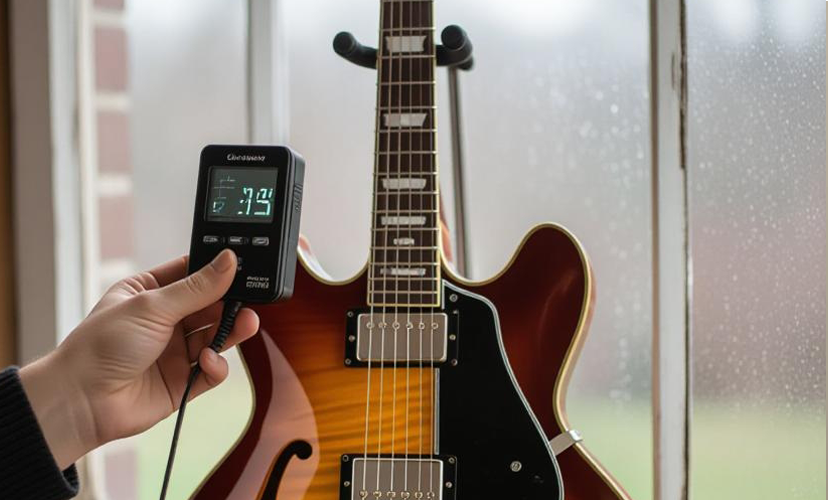
A guitar’s setup affects playability and tone. While some adjustments require a professional luthier, you can perform basic checks at home.
Neck Relief
The neck’s curvature (relief) affects action (string height). Too much relief makes strings hard to press; too little causes fret buzz.
Check:
- Tune the guitar to standard pitch.
- Press the low E string at the 1st and 12th frets. There should be a slight gap (about 0.010 inches) between the string and the 6th fret.
Adjust:
- Locate the truss rod (usually at the headstock or inside the soundhole).
- Use an appropriate Allen wrench to tighten (less relief) or loosen (more relief) in quarter-turn increments.
- Check relief after each adjustment and retune.
Tip:
- If unsure, consult a professional, as over-tightening can damage the neck.
Action and Intonation
High action makes playing difficult; low action may cause buzzing. Intonation ensures notes are in tune across the fretboard.
Action:
- Measure string height at the 12th fret (ideal: 1.5-2mm for electric, 2-3mm for acoustic).
- Adjust bridge height (saddle for acoustic, bridge screws for electric) if needed.
Intonation:
- Tune open strings, then check the 12th fret harmonic and fretted note.
- If the fretted note is sharp or flat, adjust saddle position (move toward bridge if sharp, away if flat).
Tip:
- Use a digital tuner for accuracy.
5. Hardware Maintenance
Tuning Pegs
Loose or sticky tuners affect tuning stability.
Steps:
- Tighten loose tuner screws with a small screwdriver.
- Apply a drop of lubricant (like machine oil) to sticky gears.
- Replace worn tuners if they slip or won’t hold tune.
Bridge and Nut
- Inspect for wear or cracks, especially on acoustic guitars.
- Lubricate nut slots with graphite (from a pencil) to prevent string binding.
- For electric guitars, clean bridge contacts with contact cleaner to prevent corrosion.
6. Regular Inspections
Perform a full check every 6-12 months:
- Frets: Look for wear or unevenness. Minor wear can be polished with steel wool; deep grooves require professional refretting.
- Electronics (Electric Guitars): Check pickups, pots, and switches for crackling or signal loss. Clean with contact cleaner or consult a tech.
- Seams and Joints: Inspect for loose glue joints or cracks, especially on acoustic guitars.
7. Professional Maintenance
Some tasks are best left to professionals, especially for high-value guitars:
- Fret Dressing or Refretting: For worn frets or uneven fretboards.
- Setup: For precise action, intonation, and truss rod adjustments.
- Repairs: For cracks, loose braces, or electronic issues.
Schedule a professional setup every 1-2 years or after significant environmental changes.
Final Thoughts
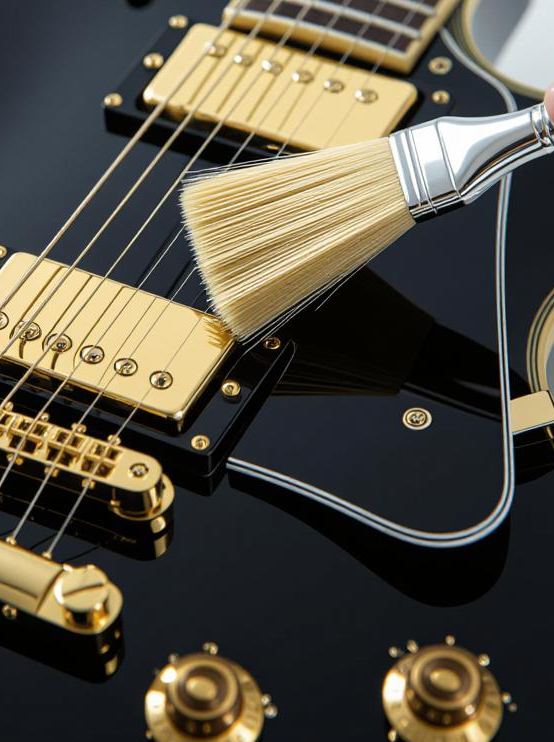
Maintaining a guitar requires consistent effort, but the rewards are worth it. A well-cared-for guitar not only sounds better but also feels more inspiring to play. By cleaning regularly, changing strings, controlling storage conditions, and checking the setup, you can keep your instrument in peak condition for years. Whether you’re a casual player or a dedicated musician, these practices will ensure your guitar remains a reliable companion.